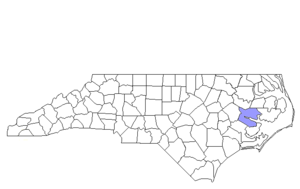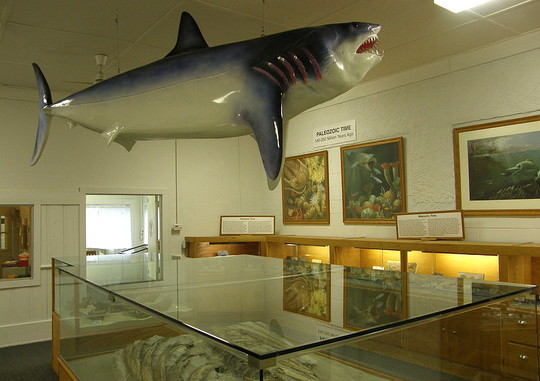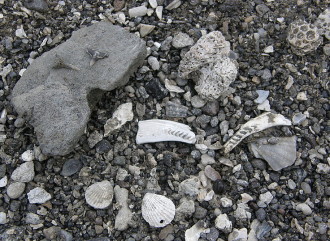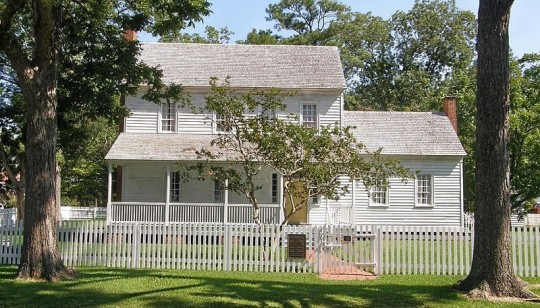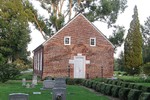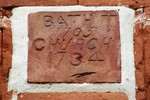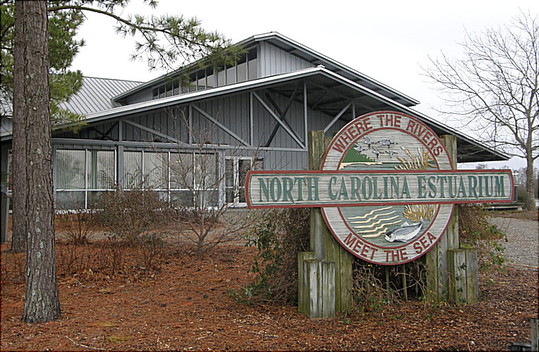BEAUFORT COUNTY
Scroll down this page or click on specific site name to view features on the following Beaufort County attractions/points of interest:
Aurora Fossil Museum, Belhaven Memorial Museum, Goose Creek State Park, Historic Bath State Historic Site, North Carolina Estuarium
Fast facts about Beaufort County:
Created in 1712, the county is named for Henry Somerset, Duke of Beaufort, one of the Lords Proprietors.
The county seat is Washington, named for General George Washington. Other communities include Aurora, Bath, Chocowinity, Pantego, and Pinetown.
Beaufort County’s land area is 827.97 square miles; the population in the 2010 census was 47,759.
It is noteworthy that Washington was the first town in the country to be named in honor of George Washington; Bath, established in 1705, is the oldest incorporated town in North Carolina and was briefly home to the pirate Blackbeard.
Aurora
Phosphate mining began outside the small eastern North Carolina town of Aurora in 1964. A by-product of this mining was the discovery of thousands upon thousands of fossilized sea life from over 15 million years ago. Some of these relics are showcased in the Aurora Fossil Museum. Exhibits include excavated bones, shells, petrified wood, Indian tools, arrowheads, and prehistoric sharks’ teeth, all uncovered at the nearby phosphate mine. The collection of arrowheads is especially interesting, with some measuring nearly 6” in length, others 2 ½” in width. The museum also features the reconstructed dentition of a shark, painstakingly collected and arranged for display over a year-and-a-half period. An 18-minute film in the museum’s theater explains the geological events which caused this phosphate bed to form along North Carolina’s coast. Sponsored by PCS Phosphate, the company operating the Aurora mine, the film shows the enormous bucket wheel excavators and the huge drag lines used to dig the phosphate beds. To quell the concerns of environmentalists, the film quickly points out that the phosphate layers are only briefly exposed, and they are soon converted back into croplands, wetlands, and woodlands. The exhibit rooms are covered with large illustrations that, like the film, help to explain how the phosphate beds were formed, what sea creatures lived in the oceans at the time, and why this rich bed of phosphate is so important.
Across the street from the museum building is the fossil pile. Here, children and adults alike can have fun searching for their own fossils. Fresh material is brought in periodically from the nearby mine, so it is almost a certainty that you’ll discover a number of fossils. Thirty minutes of light digging and sifting will likely yield pieces of coral, oyster and clam fragments, small shells, and sharks’ teeth – lots and lots of sharks’ teeth. What makes these relics different from any you might find on an average trip to the beach is that the ones you uncover at Aurora are all prehistoric! There’s no shade on the pile, however, so bring some sun block. Remember to bring your own spades and a few plastic bags in which to carry home your treasures. It’s dusty fun, so a few moist wipes would be a good idea, too. The Museum provides a free fossil tooth identification guide to help you determine if the tooth you’ve uncovered comes from a great white, a hammerhead, or one of a dozen other types of sharks. A small park adjacent to the pile offers a comfortable spot for picnics before or after a dig. Museum hours are 9-4:30, Monday through Friday. Closed Saturday and Sunday. Admission is free. Visitors can sift through the fossil pile from dawn to dusk, seven days a week.
Belhaven
The Belhaven Memorial Museum might well be one of the most unusual attractions you’re ever likely to encounter. A cross between grandma’s attic and Ripley’s Believe It or Not, it’s worth taking in, if only for the novelty of the experience. Belhaven, French for “beautiful harbor,” is situated along the Pungo River in the eastern corner of Beaufort County. The town was once the site of an Algonquian village. When first settled by Europeans, it was called Jack’s Neck; later, it was renamed Belle Port. It wasn’t until 1893 that Belhaven appeared on North Carolina maps. The fine red brick edifice that houses the Belhaven Memorial Museum is worth a visit in and of itself. Originally the town hall, the remarkable building is listed on the National Register of Historic Places.
Many of the items on display in the museum are the kind of things you’d expect to find in grandma’s attic. In this case, “grandma” was Eva Blount Way, a longtime resident of Belhaven. Orphaned at an early age, Eva lived with relatives, and perhaps feelings of insecurity led her to seek comfort in collecting things. Supposedly, Eva began by saving buttons. By the time of her death, items in her collection ranged from coins to kitchenware and from farm tools to fire arms. Her Quaker husband often described her as “a little girl who never grew up,” and he evidently humored her seemingly insatiable passion for collecting both trash and treasure. When Mrs. Way died in 1962, she bequeathed her collection to the community, and the Belhaven Memorial Museum opened in 1965.
There is no particular organization to the items on display. As though they were digging through an old trunk crammed with mementos, visitors are on their own to find things of interest, and they’ll soon discover that the eclectic collection ranges from the mundane to the morbid. Close inspection will reveal a yellowed copy of the New York Herald, dated April 15, 1865, reporting the details of President Lincoln’s assassination. Easier to spot is the suit worn by Eva’s father at his wedding. There’s a South Carolina marriage certificate from 1739 and a flower wreath made with human hair from the mid-1800s. There are mementos from 1954’s Hurricane Hazel. The interstate highway system we take for granted today could scarcely have been imagined by anyone in eastern North Carolina way back in 1939. A handbill on display from that year announces a meeting to be held intending to impress upon state highway officials the need for a dependable “all-weather” – that is to say, paved – road from Pantego to Plymouth, a distance of some 23 miles. Sharing space with these and many other ordinary items from the past are large glass jars containing the preserved remains of a 4-legged chicken, an 8-legged pig, and a tumor, weighing nearly six pounds, removed from a woman at the Pungo District Hospital. You won’t want to miss the two fleas dressed in wedding apparel, either. The Museum is certainly easy to find. It occupies the second floor of the Old Town Hall building, a handsome brick building on US 264 Business in downtown Belhaven. The Belhaven Memorial Museum is open daily except Wednesday, 1-5. Closed major holidays. Free Admission is free; donations accepted. 252-943-6817
West of Bath
Goose Creek State Park is exactly the kind of natural setting one would expect to find in the eastern part of the Tar Heel State. Situated only a few miles west of historic Bath, North Carolina’s first incorporated town, the 1,667-acre park is a blend of hardwood forest, freshwater swamps, and brackish marshlands. Outdoor activities include nature walks, boating and canoeing, fishing, swimming, picnicking, and primitive camping. The park also features a visitor’s center with a Discovery Room filled with an amazing assortment of animal mounts.
Goose Creek State Park is bordered on the south by the Pamlico River; Mallard Creek is at its eastern edge and Flatty Creek and Goose Creek are along its western boundary. Trail maps available at the visitor’s center help explorers to “discover the wonder of wetlands without getting [their] feet wet.” Numerous trails are designed to focus on different aspects of the park. The Palmetto Boardwalk Trail, for example, is a .7 mile excursion through a hardwood swamp. As the name suggests, the trail passes through stands of dwarf palmetto trees. Skinks and lizards – along with an occasional snake – are often spotted on or near the boardwalk. White-tailed deer are also frequently seen. More often heard than actually seen are pileated woodpeckers and a variety of frogs. The Goose Creek Trail stretches nearly two miles east to west across the park, through an area where a mixed pine and hardwood community blends into a black gum swamp community. River cane is plentiful in this transitional zone. The Flatty Creek Trail, one mile in length, winds its way through fresh and brackish water wetlands. It ends at an elevated observation deck that offers picturesque views of Flatty Creek, the Pamlico River, and the surrounding marshes. Naturally, this is one of the major wildlife viewing areas in the park, especially for shorebirds. Spring and summer is a good time to see ospreys; fall and winter is the time to spot bald eagles. For scenic beauty, however, the Live Oak Trail might be the best. Towering live oaks festooned with Spanish moss adorn the 1.2 mile walk, which leads visitors to a sandy shoreline and views of the Pamlico River. This area of the park also features the designated swimming area.
On the western edge of the park is Dinah’s Landing, which provides access for boating and canoeing. Picnic facilities under shade trees at the landing provide opportunities for unhurried meals in a tranquil setting. Fishing is permitted in creeks and river. A state fishing license is required. Common catch include largemouth bass, bluegill, and perch. The quiet waters of Goose Creek offer canoeists the perfect opportunity to view nature from a different vantage point; visitors must bring their own canoes, as none are available for rent at the park.
The highlight of the modern visitor’s center is the Discovery Room. Animal mounts include all manner of wildlife: red wolf and raccoon, gray fox and fox squirrel, opossum and muskrat, bobcat and beaver; red-tailed hawk, wild turkey, tundra swan, and screech owl; spotted, box, and snapping turtles; and king, rat, and corn snakes. The center also features a bird observation station, an outdoor butterfly garden, learning activities for the children, and a brief video entitled “Discover the Wetlands.” Visitors enjoying the park might also find the North Carolina Estuarium in Washington worthwhile. Hours are 8 AM to 9 PM from June-August; 8-8 in April, May, and September; 8-7 in March and October; and 8-6 from November-February. Admission is free. Visitors to the park are cautioned to be mindful of ticks, wear appropriate clothing, and use insect repellant. 252-923-2191
Bath
In the middle of the 17th century, settlers from the Virginia tidewater began trickling into the northeastern corner of what was to become North Carolina, making the Albemarle region the first part of the province to be settled. It is not surprising, therefore, that the state’s first incorporated town is found in this area. The town of Bath is located in Beaufort County on Bath Bay, about thirteen miles east of Washington. In its brief heyday, Bath was home to many of North Carolina’s most notable figures: Christopher Gale, the colony’s first Chief Justice; John Lawson, Surveyor General of Carolina and author of A New Voyage to Carolina; Royal Governors Thomas Cary and Charles Eden; and even the notorious pirate Blackbeard, who may or may not have retired from practicing his trade during the short time he lived here.
One of North Carolina’s official ports of entry, Bath was among the province’s most important towns in the early 1700s and very nearly was named as the location for the North Carolina’s capital. It’s ultimate fate, however, was to remain a relatively small village, overshadowed by Edenton, New Bern, Wilmington, and, eventually, Washington, when that town became the county seat in 1785. Some says this was the result of a curse placed on the town by a disgruntled pastor.
Today, three of the town’s most significant buildings are open to the public as part of Historic Bath, one of more than twenty sites maintained and operated by the State of North Carolina. The oldest of these is the Palmer-Marsh House, built circa 1751 for Michael Coutanch. Colonel Robert Palmer, Surveyor-General of the state from 1753-1771 and Collector of Customs for the Port of Bath, purchased the house in 1764. Royal Governor William Tryon was an occasional guest at the home and described it as “a very excellent house.” It is among the oldest surviving buildings in the state.
Another fine home is the 19th century Bonner House, a two-story white frame dwelling that overlooks picturesque Bath Bay. It is believed that the house is built on the site of John Lawson’s home. Stones forming the base of Lawson’s kitchen are seen just to the left rear of the current house. The Jacob Van Der Veer House, circa 1790, is self-guided and contains numerous exhibits chronicling Bath’s three centuries. The visitor center also features a small museum, theatre, and gift shop. Bath is also home to the quaint St. Thomas Episcopal Church. Built in 1734, the small brick edifice is the oldest church building in the state. Historic Bath is open 9-5 Tuesday through Saturday. Small fee charged for separate guided tours of the Palmer-Marsh and Bonner Houses. 252-923-3971
Washington
Since opening in January, 1998, the North Carolina Estuarium in Washington has been focusing attention on the watershed region of Pamlico Sound, where “the rivers meet the sea.” A visit to the Estuarium begins with a 12-minute film entitled “Journey through the Peninsula.” Light on dialogue, the video instead relies upon superb photography and appropriate background music to show the diversity of plant and animal life dependent upon the environment provided by the Tar-Pamlico River and Pamlico Sound. The Tar River begins 125 inland from Washington and is fresh water. The Pamlico is the lower stretch of the same river and is much saltier. The river changes its name at the bridge in Washington. The Tar-Pamlico is like the Neuse River in that its tides are affected by the wind; by contrast, the Cape Fear River, with no barrier islands to block the ocean, is affected by lunar tides. Pamlico Sound is a shallow body of mixed fresh and salt water enclosed by the Outer Banks except for four inlets. Stretching 90 miles from north to south and 25 miles across at its widest point, Pamlico is the largest lagoonal estuary in the United States. Covering 2,000 square miles, it is larger than the state of Rhode Island.
The Estuarium is rewarding for adults, but it is also kid-friendly, with lots of hands-on exhibits children can use. In the lobby, for example, stands an elaborate sculpture by Washington resident Whiting Tyler. 365 wires radiate from the “sun,” 28 wires from the “moon,” and lightweight balls are used to represent drops of water. “Evaporating” to the top of the sculpture by vacuum, the balls roll along a meandering chute until they fall from the “sky” as rain. Kids standing on duck feet painted on the floor can catch the raindrops. Inside, an exhibit entitled “People and the Pamlico” shows how inhabitants interact with their environment, earning their living in diverse ways. A video showing informal interviews with local residents plays continuously. To a person, those interviewed stress the importance of the region’s water quality and natural beauty. As one local states, the Tar-Pamlico River and Pamlico Sound are “the centerpiece to our whole region.”
A special mid-week attraction available spring through fall is the opportunity to go “river roving” on board a 24-foot pontoon boat. Two trips are taken Wednesdays, three on Thursdays. The trips are free of charge with admission to the Estuarium, but each trip is limited to twelve passengers, so it is important to book early if you want to go. The Estuarium is one of four Partnership for the Sounds facilities, promoting environmental education and nature-based tourism on the Albemarle-Pamlico peninsula. The other sites are the Columbia Theatre Cultural Resources Center in Columbia, the Mattamuskeet Lodge in New Holland, and the Roanoke/Cashie River Center in Windsor. The NC Estuarium is located on Water Street in Washington and is open Tuesday-Saturday 10-4. Admission charged.
Beaufort County is bordered by CRAVEN, HYDE (Region One), MARTIN (Region Two), PAMLICO, PITT (Region Two), and WASHINGTON (Region One) counties.
Return to REGION THREE HOME PAGE.
Return to GEOGRAPHIC REGIONS HOME PAGE.


